Alcazar
Author: Wolfgang Kramer
Publisher: Kosmos
Year: 2009
review by

| x |
|
|
|
|
|
|
|
|
|
|
|
|
|
|
|
|
|
|
|
|
|
|
|
|
|
|
|
|
|
|
|
|
|
|
|
|
|
|
|
|
|
|
|
|
|
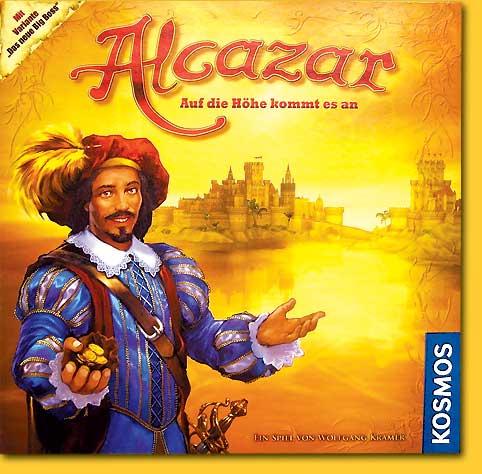 |
A corner on the box states: ‘with the new Big Boss variant’, thereby making clear what ‘Alcazar’ actually is. Or could be. Or isn’t. ‘Big Boss’, that itself was a derivate of Sid Sackson’s ‘Acquire’, had been many years out of print and the hype around it caused second hand copies to sell for exorbitant prices. The call for a reprint was high. Maybe because ‘Big Boss’ had too much resemblance with ‘Acquire’, and to take out some supposedly iniquities, the game got a further development before it hit the market as ‘Alcazar’. And this is terribly unfortunate. |
| What made ‘Big Boss’ so much fun anyway? The game was about founding companies with fake auto brands such as ‘Royal Rose’ or ‘Lord’. Shares could be bought, and the company chains could be expanded with numbered build cards that increased the company’s value. |
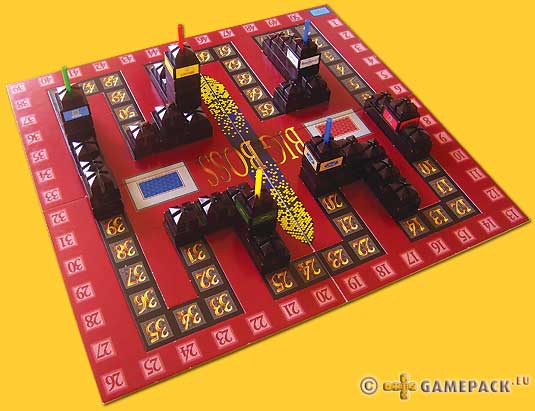 |
Mergers between chains made the game just like ‘Acquire’ exciting as this way the larger chain would be increased by adding the value of the smaller chain which got liquidated. By taking shares in the chains a player would earn money - and all was about money.
|
|
|
|
|
|
|
| In the new ‘Big Boss’ all still is about money, but the shares have vanished. The setting changed too; players now are in Spain to build castles. They have six barons and two super barons to place in the erected castles that give money the same way the shares did. Because in ‘Big Boss’ careless players could get stuck wit no money and no playable build cards, a few changes have been made. |
|
|
|
|
|
|
| x |
|
|
|
|
|
|
|
|
|
|
|
|
|
|
|
|
|
|
|
|
|
|
|
|
|
|
|
|
|
|
|
|
|
|
|
|
|
|
|
|
|
|
|
|
|
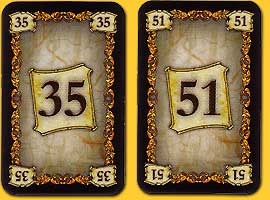 |
A display of six cards makes it less random for players when they want to buy a card, although they still may buy one from the blind stock. Besides erecting or expanding a castle players now also may build a mansion that is not subject to the three free spaces from an existing chain rule. This makes unplayable cards in the ‘old’ Big Boss’ now playable, and besides this they are a real threat to neighbouring castles: when a mansion merges with a castle, the baron stays in the mansion and now is part of the larger, more valuable chain. |
|
|
|
|
|
|
| x |
|
|
|
|
|
|
|
|
|
|
|
|
|
|
|
|
|
|
|
|
|
|
|
|
|
|
|
|
|
|
|
|
|
|
|
|
|
|
|
|
|
|
|
|
|
| Further the floor cards are not part of the build cards anymore but are all in one stack that each player can buy for 10 money to raise the level of a castle. When all towers have been placed the game ends and the value of the barons inside the castles is paid out according to the size of the castles they are in. |
|
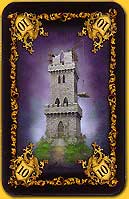 |
| x |
|
|
|
|
|
|
|
|
|
|
|
|
|
|
|
|
|
|
|
|
|
|
|
|
|
|
|
|
|
|
|
|
|
|
|
|
|
|
|
|
|
|
|
|
|
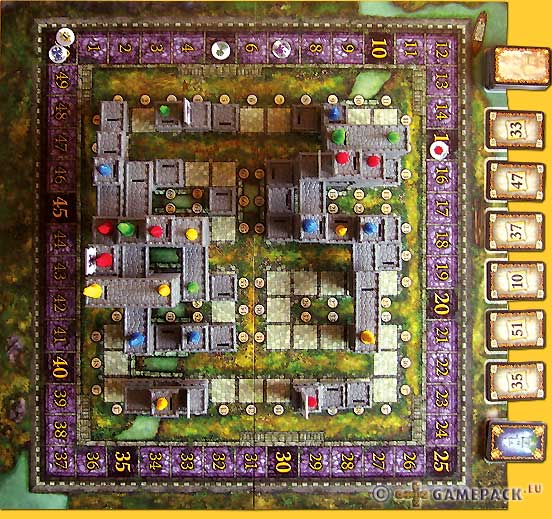 |
| x |
|
|
|
|
|
|
|
|
|
|
|
|
|
|
|
|
|
|
|
|
|
|
|
|
|
|
|
|
|
|
|
|
|
|
|
|
|
|
|
|
|
|
|
|
|
| ‘Alcazar’ goes one step further. Again no shares are part of the game. But it is no longer money it is about, but the barons that play an even more important part. At the end of the game these score as much points as the floor level they occupy. Mergers are even more tactical as the barons in the smaller chain are not removed. |
|
|
|
|
|
|
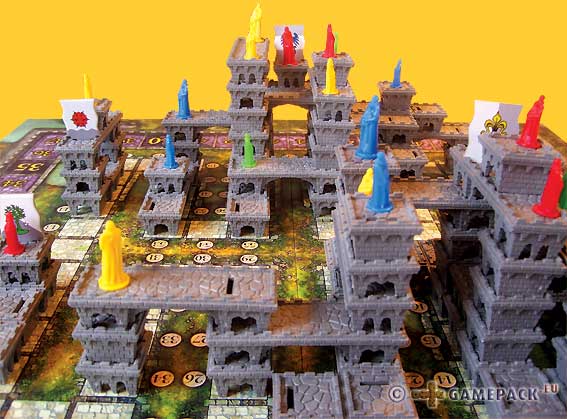 |
|
|
| x |
|
|
|
|
|
|
|
|
|
|
|
|
|
|
|
|
|
|
|
|
|
|
|
|
|
|
|
|
|
|
|
|
|
|
|
|
|
|
|
|
|
|
|
|
|
| With the introduction of bridges the barons can increase their floor level and besides this a merger can come from more than two directions as various not numerical sequenced spaces can be connected by a bridge. ‘Alcazar’ ends when all towers or bridges have been placed. |
|
|
|
|
| x |
|
|
|
|
|
|
|
|
|
|
|
|
|
|
|
|
|
|
|
|
|
|
|
|
|
|
|
|
|
|
|
|
|
|
|
|
|
|
|
|
|
|
|
|
|
| x |
|
|
|
|
|
|
|
|
|
|
|
|
|
|
|
|
|
|
|
|
|
|
|
|
|
|
|
|
|
|
|
|
|
|
|
|
|
|
|
|
|
|
|
|
|
| x |
|
|
|
|
|
|
|
|
|
|
|
|
|
|
|
|
|
|
|
|
|
|
|
|
|
|
|
|
|
|
|
|
|
|
|
|
|
|
|
|
|
|
|
|
|
 |
|
|
|
|
|
|
|
|
|
|
|
|
|
|
|
|
|
|
|
|
|
|
|
|
|
|
|
|
|
|
|
|
|
|
|
|
|
|
|
|
|
| ‘Big Boss’ was a nice and fast, uncomplicated game with a functional execution. The blocks in ‘Big Boss’ stack real easy, and the chains are kept in line through a simulated relief printing on the game board. But players who think by buying ‘Alcazar’ they also will acquire the old ‘Big Boss’, will be deceived. |
|
|
|
|
| x |
|
|
|
|
|
|
|
|
|
|
|
|
|
|
|
|
|
|
|
|
|
|
|
|
|
|
|
|
|
|
|
|
|
|
|
|
|
|
|
|
|
|
|
|
|
The rather abstract blocks are replaced by moody towers alright, and much effort has been made to give the game atmosphere. But this is at the expence of functionality: the towers stack a bit awkward, and with no relief printing on the board they often stand out of line. It is also inconvenient that the sounding fantasy names and clear and unmistakable colours of the chain have been replaced by even fancier medieval shields that make it hard to distinguish them.
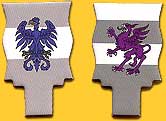 |
 |
| x |
|
|
|
|
|
|
|
|
|
|
|
|
|
x |
|
|
|
|
|
|
|
|
|
|
|
|
|
|
|
|
|
|
|
|
|
|
|
|
|
|
|
|
|
|
|
 |
|
Another annoyance: the barons, placed on a tower with a shield, can not be seen from all angles - Oh my! Is there one of you behind?
Beside these cosmetic changes, the new ‘Big Boss’ has a totally different feel by the absence of shares and the replacement by barons. Contrary to shares however, the barons cannot be depleted as each player has his own set of barons and this enables each player to participate in a large castle on which they usually jointly build.
The tower cards are very desired just as they were in the old ‘Big Boss’. When players have enough cash there is a run on the tower cards until the stack is depleted. In testing rounds a hand limit could not resolve this, according to the author, who emphasizes the importance of the tower cards should not be overestimated; an opinion that leaves room for discussion. Still it is a bit weird that two players play the original ‘Big Boss’ in 60 minutes but need an additional 30 minutes for the new ‘Big Boss’. This may be due to the many additional placement rules that offer a more tactical play, but from which the game gets tougher and thereby slower. |
| x |
|
|
|
|
|
|
|
|
|
|
|
|
|
|
|
|
|
|
|
|
|
|
|
|
|
|
|
|
|
|
|
|
|
|
|
|
|
|
|
|
|
|
|
|
|
In ‘Alcazar’ things get even more confusing; through the placement of bridges the game gets a real attractive sight but it does not add to the overview. More numbers on the board give connection to chains. The display of six cards also slows down the speed as each card must be considered. And the placing of barons and shields when placing a new tower is quite clumsy.
Towards the end of ‘Alcazar’ almost all players have their barons in an optimal position; yet players quite meaningless have to continue until the end condition is met and all towers or bridges have been placed. |
|
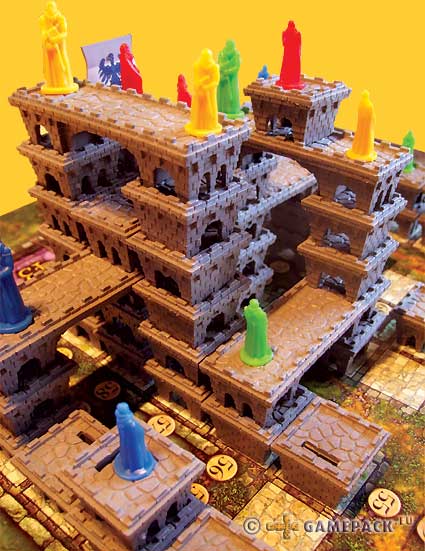 |
| x |
|
|
|
|
|
|
|
|
|
|
|
|
|
|
|
|
|
|
|
|
|
|
|
|
|
|
|
|
|
|
|
|
|
|
|
|
|
|
|
|
|
|
|
|
|
And so there are various things a player must unlearn to learn and value ‘Alcazar’. It actually is better for new players to not know ‘Big Boss’ when they start with ‘Alcazar’; the ‘Big Boss’ variant should be wholly ignored.
|
| x |
|
|
|
|
|
|
|
|
|
|
|
|
|
|
|
|
|
|
|
|
|
|
|
|
|
|
|
|
|
|
|
|
|
|
|
|
|
|
|
|
|
|
|
|
|
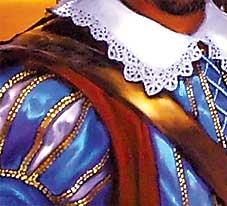 |
A special comment on Eckhard Freytag who has drawn a beautiful and moody cover illustration; one can feel the concentration and passion it is illustrated with. The light on the glossy silk and the other details of the clothes of the baron are very realistic and of a seventeenth century-like precision. With a royal blue that emits so clear and is so brilliant of course this is due to a splendid printer too. |
| x |
|
|
|
|
|
|
|
|
|
|
|
|
|
|
|
|
|
|
|
|
|
|
|
|
|
|
|
|
|
|
|
|
|
|
|
|
|
|
|
|
|
|
|
|
|
It seems like a marketing error; ‘Big Boss’ should have been reprinted unchanged and ‘Alcazar’ printed as a separate title. In that case the predecessor ‘Big Boss’ wouldn’t distract the attention of ‘Alcazar’ and without this foreknowledge it would be appreciated on its own. But as it is now a comparison between the two is obvious. It shouldn’t be like this but is inevitable through the splits we are presented with with ‘Alcazar - the new Big Boss’.
© 2010 Richard van Vugt
Alcazar, Wolfgang Kramer, Kosmos, 2009 - 2 to 5 players, 10 years and up, 60-90 minutes
|
  |
A missed opportunity: a 5 for the new 'Big Boss' |
  |
|
|
|
A 5 for the superfluous new 'Big Boss' |
  |
|
|
|
|
|
|
|
|
|
|
|
|
|
|
|
|
|
|
|
|
|
|
|
|
|
|
|
|
|
|
|
|
|
|
|
|
|
|
|
|
|
  |
Beautifully executed game, but because of the non intuitive rules the game never gets entertaining |
| x |
|
|
|
|
| x |
|
|
|
|
|
|
|
|
|
|
|
|
|
|
|
|
|
|
|
|
|
|
|
|
|
|
|
|
|
|
|
|
|
|
|
|
|
|
|
|
|
|
|
|
|
 |
|
|
|
|
|
|
|
|
|
|
|
|
|
|
|
|
|
|
|
|
|
|
|
|
|
|
|
|
|
|
|
|
|
|
|
|
|
|
|
|
|
 |
|
|
|
|
|
|
|
|
|
|
|
|
|
|
|
|
|
|
|
|
|
|
|
|
|
|
|
|
|
|
|
|
|
|
|
|
|
|
|
|
|
| x |
|
|
|
|
|
|
|
|
|
|
|
|
|
|
|
|
|
|
|
|
|
|
|
|
|
|
|
|
|
|
|
|
|
|
|
|
|
|
|
|
|
|
|
|
|
 |
|
|
|
|
|
|
|
|
|
|
|
|
|
|
|
|
|
|
|
|
|
|
|
|
|
|
|
|
|
|
|
|
|
 |
|
|
|
|
|
|
|
|
|
|
|
|
|
|
|
|
|
|
|
|
|
|
|
|
|
|
|
|
|
|
|
|
|